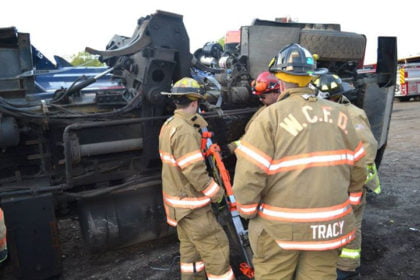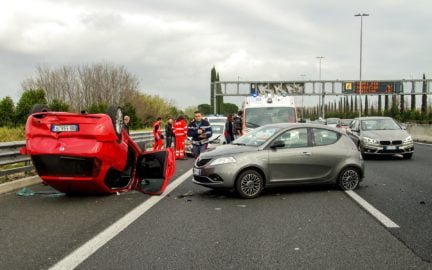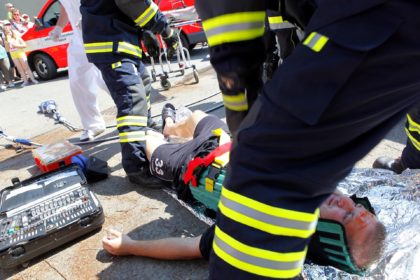Imagine you’re driving home from a wonderful dinner out with your partner and friends. It’s dark, and as you turn a corner of country road you see the twisted chunks of metal and plastic that used to be two separate cars.
What do you do? Are you helpless? Do you just call 911 and then wait while freaking out? Take a Snapchat as you rubber-neck on past?
These are your roles as a prepared bystander:
- Contacting emergency services.
- Being a calm, cool head that can help guide people and communicate with 911.
- Getting people out of harm’s way, like an injured person lying in traffic or someone in a burning car.
- Giving basic and necessary first aid such as stopping major bleeding and CPR.
The well-researched Bystander Effect says that the more people who witness a crash, the less likely any one of them will step up and help.
You can be better prepared, because you owe it to yourself and others to be your own first responder. Minutes are crucial, and having an idea of what to do beforehand can make a lifesaving difference. Be the person who is prepared and steps up.
Key things to remember:
- Protect yourself first.
- Keep your wits.
- It’s better to take 10 seconds and evaluate the situation instead of running right in.
- Always call 911. Don’t assume others have.
- Give 911 quick, short, clear answers.
- Don’t move seriously injured people unless you have to (like seeing flames in the car).
- Keep people away from the road.
- Don’t play doctor. Give basic first aid and possibly help with breathing (CPR) or major bleeding.
- Keep the area clear (like keeping your car down the road) so emergency services have room to work.
- When the professionals arrive, give them the right quick info and get out of their way.
- Don’t be afraid to get help if the experience troubled you.
Why you should trust us
I’ve been a firefighter since 2005, and have responded to hundreds of vehicle accidents, from mopeds to train derailments. I’m also a certified Fire Service Instructor in the state of Connecticut who teaches and trains regularly on vehicle extrication and fire-rescue response.
Get prepared ahead of time
Good news! You’re doing most of the preparation right now by reading this guide. You’re exercising your brain and even if you don’t remember specific things later when you need it, simply by thinking through the situation now you will be more prepared than average people.
We highly recommend that you take a basic first aid and CPR course. Check the American Heart Association or the Red Cross to find a class nearby. It’s a small investment, usually 2-3 hours, and could easily save a life one day.
Part of The Prepared’s basic emergency preparedness checklist is a Get Home Bag. It’s the one bag of supplies you have with you when you’re away from home. For most people, it’s in the trunk of their car.
So in these situations you’re likely going to have it with you and it can be a huge help. You might use these supplies:
- Flashlight
- Medical kit
- Gloves (both medical and ‘work’ gloves)
- Signal flares — they help with traffic diversion and if emergency services can’t easily find you
- Hand sanitizer
- Window breaker and seatbelt cutter — there are full sized ones, but I also carry a keychain sized tool from Resqme and have found it to be one of the best.
Good Samaritan laws
There are some potential legal issues around Good Samaritan laws. We want to do more research before talking about it deeply here, partly because the laws are so different from one state to another.
Some states, like Vermont, have laws that require citizens to help those in need. Other states say that if you made reasonable and well-intended decisions when helping someone in need, you are protected from liability.
Others, like Oklahoma, only protect untrained rescuers if they are doing basic and necessary things like CPR or controlling major bleeding.
Keep cool and protect yourself first
Even professional first responders are trained to evaluate situations before they jump in. So look before you leap, because adding one more body to the pile helps no one.
When I’m teaching fire service and rescue, we always teach the importance of mindset in emergency situations. Having a clear head is one of the most important things in a crisis.
Different teachers and different fields (military, rescue, law enforcement, etc.) all have their own special acronym or method for explaining the same basic concept. As a fire service instructor, we teach the critical steps of assessing the situation, deciding on a course of action, and acting on that decision. The military has the OODA loop: observe, orient, decide, act.
They all mean the same thing — take a deep breath and intentionally look at what’s happening before you make a decision. The extra 10 seconds you might spend “standing there thinking” might feel unnatural or wasted, but it is almost always better than immediately rushing into something.
Look for any dangers like downed wires, leaking fluids, and other debris. Pull your car off the road and don’t park too close to the accident so that emergency services have room. Activate your hazard lights.
Remember, you can’t help if you become part of the incident yourself. For example, in April of 2017 a Detroit doctor was struck and killed by another vehicle as she stopped to help six teenagers in an overturned Jeep.
Call 911 quickly and give the right info
Your biggest value as a bystander is to call emergency services and have a cool head. Those two things alone are super helpful and, unfortunately, becoming more rare.
So many people waste precious time and even make things worse by telling emergency services pointless information. It’s understandable since most of us have very little practice thinking and talking in a crisis.
Get your phone and call 911 as quickly as you can. Maybe you haven’t even pulled over and checked out the scene yet, but you know it’s bad just from the first glance.
Don’t just assume that someone else has called 911. There are plenty of examples of multiple people standing around assuming someone else made the call. Don’t be like them.
Here’s a good example of the first words out of your mouth after the dispatcher asks “911, do you have an emergency?”
“There’s a bad car accident on a road in the woods at the west end of town.”
Yet most people ramble with answers like, “Yeah my husband and I were driving home from dinner and we turned the corner and it looks like there’s a car wreck. Hold on we’re pulling over, I don’t know how bad it is. I don’t know the address. Honey, do you know what street we’re on?”
They don’t know if you’re calling because you’re stuck in an elevator, pissed off at your neighbor, or your dog just ate your special brownies. They have no idea where you are.
Give them the right info quickly that there’s a car accident and at least a general idea where it is so they can start pressing buttons to get first responder crews rolling in the right direction. You can give more details over time and the dispatcher will update the responders over the radio.
911 operators are specifically trained to get the right info they need from shocked civilians. So keep your answers short and sweet, and don’t be afraid to say things like “I don’t know” instead of guessing.
Important information 911 will want:
- Location.
- Number of vehicles involved.
- Number of people involved and/or number of people injured.
- Any other hazards like downed power lines, leaking fuel, fire, etc.
You’ll probably stay on the line with 911 until emergency responders arrive. If you need to, give the phone to someone else who can narrate while you have both hands free.
All of the following advice, like giving basic first aid, is subject to what the 911 operator is telling you to do. They’re in charge.
What to expect at the scene
Assuming the crash just happened and you’re the first person around, things will be understandably chaotic or unclear. The more you know what to expect, the better you can keep a cool head.
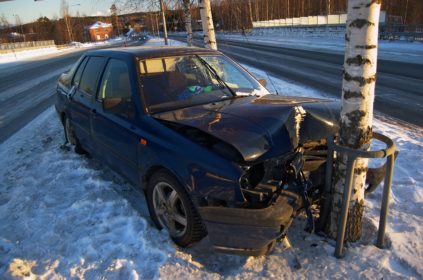
Modern vehicles are designed with “crumple zones” that absorb the crash energy in an attempt to protect where passengers sit. Which means that many wrecks will involve nasty structural damage around the car and you’ll see debris like broken glass and metal spread all over.
You may notice a burning smell as engine oil and fluids spill out. You might find passengers that were ejected from their vehicle, sometimes surprising distances away. People might be screaming or shouting for help. It might be gruesome.
Don’t just focus on the people. What else is going on? Take a good look at the vehicles to see if any fluid is leaking. Notice if the vehicles are stable on flat ground, on their sides or upside down, in a ditch, or tilting over an embankment.
How to help people
Survivors can obviously have anything from minor bumps to truly shocking injuries.
If you are untrained, attempting anything above and beyond basic first aid may do more harm than good. Always listen to the 911 operator.
Colorado paramedic Steve Whitehead points out that you shouldn’t just focus on the people making the most noise: “Noisy patients typically have patent (open) airways and adequate breathing. While a noisy patient may have critical injuries, never assume that a quiet occupant is quiet simply because they are uninjured.”
There are interesting studies about how witnesses of car accidents respond (or don’t) to the emergency. The data shows that bystanders are less likely to help the more injured someone is. One main reason is that people with minor injuries tend to be calling out for help, whereas someone with serious injuries probably isn’t.
Other factors are fear of infection, concern about personal liability, and a general sense that they don’t know what to do. This pattern comes up again and again in research about ‘Good Samaritans’ – the single biggest factor of whether or not a bystander takes action is if they have the confidence that what they’re doing will be helpful.
Walking wounded
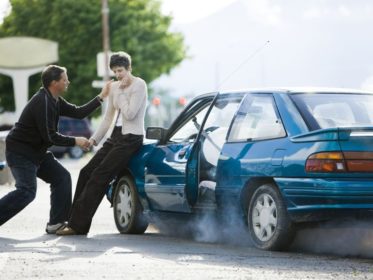
In the military and public safety world, there’s a phrase called “walking wounded.” They may be injured but can self-extricate from a car and get themselves to relative safety. They might already be out of the car and stumbling around when you arrive.
You should instruct any of these walking wounded to get to the side of the road, and to sit or lie down. Many accident victims may be dazed or confused. You cannot depend on them thinking rationally, so pay attention to signs of confusion. Plus there’s always a chance that alcohol or drugs were involved.
Getting the walking wounded to a place of safety will help them avoid wandering in the roadway and possibly getting struck by oncoming vehicles or emergency responders.
Don’t move people unless you have to
Check the vehicles for people who might be stuck or seriously injured. Despite what Hollywood portrays, car accidents very, very rarely result in a car bursting into flames in a dramatic explosion. Accidents will often create steam or smoke from the engine compartment, but that doesn’t mean it’s about to explode.
Unless you see actual flames or the car is about to be crushed or fall off a ledge, it’s best to leave an injured person in the vehicle until help arrives. Moving them unnecessarily could make their injuries worse, especially serious ones like spinal injuries.
If it does become necessary to remove an occupant from their seat, be wary of airbags that might suddenly deploy and be careful of hazards such as blood or broken glass. Try not to get any blood on you. If you do, clean the area with soap and water as soon as possible and tell medical personnel later.
Giving first aid
If you’re on the phone with 911, listen to their instructions and/or tell them what you are doing.
Teaching first aid is beyond the scope of this guide. But it’s always worth getting some basic training, so check out a local or online class.
You might see major bleeding from a limb, for example. Since a well-made get home bag or car kit has a tourniquet, and a good prepper knows how to use it, you’re able to take some quick and simple steps that drastically increase the injured’s chance of survival.
More: See the review of the best tourniquets and then learn how to use a tourniquet.
You should be hearing sirens by now. Take another look around to make sure you, your car, and any walking wounded are off the road and out of the way. There are examples of when someone survived a crash but was later hurt or killed by passing traffic or emergency services pulling into the scene.
When an airplane crashed at San Francisco Airport in 2013, one of the passengers was still alive after she was thrown out of the airplane onto the runway. But she was then run over by a fire truck and killed.
Emergency services arrive
At this point the professionals are on scene, so it’s time for you to take a deep breath and congratulate yourself on keeping a level head and helping some people.
Be careful not to get in the way, linger, or slow things down. Firefighting and emergency personnel are the professionals, and no matter how willing and able you are to assist them, they may not need your help. Don’t feel bad if they don’t spend a lot (or any) time talking to you. Trust their judgment.
Some people wonder why a car accident requires police, ambulance, and fire department personnel. It’s not overkill — each one has a role to play.
The fire department’s main priority will be to stabilize the scene by addressing any fire concerns, rerouting traffic around the area or blocking the road, and securing the accident vehicles to keep them stable. Sometimes they’ll use wooden cribbing or metal struts to keep a vehicle stable.
Depending on the severity of the accident, they may use hydraulic cutters (“the jaws of life”) to extricate a patient from the vehicle.
According to an April 2016 article in Fire Engineering magazine, they will need to “Ensure ambulances and other emergency vehicles have a way in and out, and identify where they can safely turn around. Our number one objective is to stabilize the scene.”
A fire officer will be in charge of the scene. You can usually spot them by their white turnout coat or helmet.
This would be the person to find and alert to any potential hazards you’ve noted like downed wires, or spilled fuel or fluids. They may ask you some basic information about what you’ve seen or done. For example, you could pass on information like, “there’s a downed power line right past that car” or “there are two people in that car, one of them seems to have a head injury.”
Paramedics and EMS are obviously there to help the injured. They’ll need one ambulance for each injured person, which is why it’s so important to make sure you and your vehicle are out of the way of first responders and in a safe location. Things can get crowded quickly.
Their priority will be patient care. They’ll assess and package each patient for transport to the hospital. They might ask you questions about injuries you’ve noted, or any first aid care you’ve provided.
Time is essential in pre-hospital care. There’s a phrase called the “Golden Hour” that describes how the first hour after a trauma is the most important in determining a successful treatment.
Since time is such a factor with a critical patient, only try to pass on the most important information. For example, ”the man in the blue shirt had a severe bleeding wound on his arm so I applied pressure and wrapped it in a towel.”
Last but not least, there will be at least one police officer. Their job is to determine the cause of the accident and investigate any potential issues. They may ask you questions about what the scene looked like when you arrived, what vehicle people were in, any statements the occupants made to you, etc.
It will be important to communicate if you noted any evidence of alcohol and drugs or anything unusual when you first arrived. Depending on the incident, the officer may ask you to write a statement regarding anything you witnessed.
Afterwards
I’ve been a firefighter since 2005. The very first motor vehicle accident I responded to was dispatched as a motorcycle wreck on a back country road. Motorcycle wrecks are notoriously bad.
I remember my heart racing as I got off the truck, wondering what I was getting into. And more importantly, how I was going to feel about it afterwards. I didn’t know if I was prepared to deal with blood and guts, and wondered if I was really cut out to be a firefighter.
As I approached the scene, I noted a trail of blood on the pavement. Picturing the worst, my inexperienced self began to fear what I was about to see.
To my surprise and relief, I discovered the blood was from a deer that the motorcyclist had struck. The driver was perfectly fine, standing up and talking to the ambulance crew.
That night I couldn’t sleep. Despite the almost optimal outcome of a motorcycle accident with no human injuries, my brain kept racing through the different possibilities that could have occurred on that quiet country road.
Coming upon a car accident can be a traumatic experience. The everyday person is often not prepared to deal with unexpected emergency situations, and the adrenaline response from it can be intense. The aftermath of dealing with an accident, especially a severe one where people are injured, can affect you mentally and emotionally.
You might have a hard time sleeping that night. You’ll probably replay the scene in your mind, wondering what else you could have done to help.
If you feel the need to talk to someone about what you saw or experienced, don’t hesitate to seek out counseling.
Even professionals have a hard time with this, especially with gruesome scenes that involve children. Even though we deal with these things all the time, we often have “Critical Incident Stress Debriefings” with a professional counselor after major incidents. It helps us process what we experienced and work through the emotional post-stress responses.
There’s also a chance you’ll be involved as a witness for insurance, criminal, or civil actions relating to the accident. So it may be helpful, once the adrenaline has calmed down, to write down what you saw while it’s fresh in your mind.
Always improving.
These posts are continuously improved and updated to include new products, research and data, and feedback from experts and the community. Learn more.
Ideas or feedback for this page? Comment below or say hi:
Get notified when we make major updates or release new reviews:
We hate spam too and send a reasonable amount of emails.

